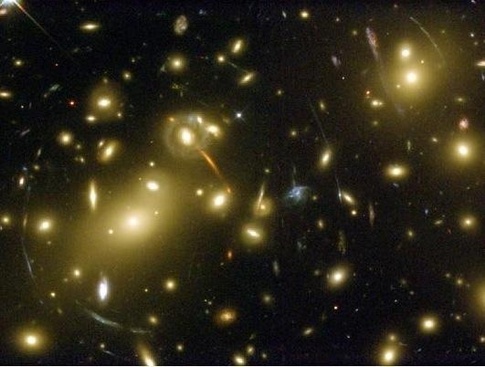Gravity is the warping of spacetime by mass or energy. A mass like the Earth warps spacetime so that the shortest path, the “path of least resistance,” for inertial movement is towards the Earth’s center.
Using instruments like the Hubble Space Telescope, it’s possible to literally see the warping of spacetime by very massive objects like galaxies and huge conglomerations of dark matter. When you’re looking at a very distant object and there’s a large mass along your line of site, it warps spacetime to produce a visual effect known as gravitational lensing. Here’s a schematic diagram showing how it works.
Here’s a real-world example of gravitational lensing, an “Einstein cross” — a single quasar is distorted by a massive object along our line of sight so it appears to be a cross of four quasars.
The arcs in this image are disc-shaped galaxies that appear warped by dark matter along our line of sight.
Here are some examples of Einstein rings, a lensing effect similar to Einstein crosses, where a massive object warps the galaxy behind it into a ring shape.
Finally, here’s a simulation of how the Milky Way disc would be lensed gravitationally if a black hole passed between us and it.
The really weird thing about gravity is that it warps time, not just space. In fact, at the scale of the earth, the time warping is more noticeable than the space warping. GPS satellites and the like need to account for the fact that they’re moving through time at a slightly different rate than objects on the ground. Pretty cool!
So how does gravity “really work” at the fundamental level? No one knows. There’s a lot of intense speculation going on in the physics community. String theory is one attractive approach.The idea is that all particles are different vibrational modes of tiny loops of one-dimensional “strings” of energy. One vibrational pattern produces electrons; a different one produces photons, and so on. If string theory is right, then one of the vibrational patterns produces gravitons, which communicate gravitational force the same way that photons communicate the electromagnetic force. In order for string theory to work, there need to be ten or eleven dimensions of space, which is either preposterous or intriguing, depending on your philosophical tastes.
No one has ever observed a graviton, and nor are we expecting to anytime soon, since gravity is so weak compared to the other forces. In general, string theory is difficult to test experimentally, so for now it remains an attractive mathematical construct in search of evidence to support it.
Another approach is called loop quantum gravity. The idea here is that spacetime is made of a tiny discrete network of loops. All of the fields and forces, including gravity, emerge from knots, links and kinks in the network.
There’s some indication that string theory and loop quantum gravity are different mathematical expressions of a single underlying theory. As with string theory, probing spacetime experimentally at the tiny scale of loop quantum gravity is very far out reach technologically, so for now, it too remains speculation, though it’s well-motivated mathematically. Only time will tell what the true story is.







